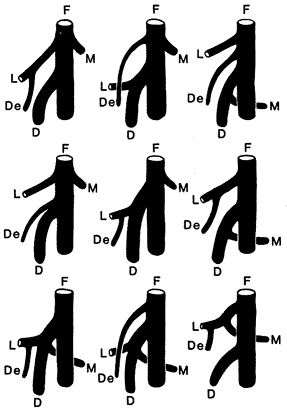

Illustrated Encyclopedia of Human Anatomic Variation: Opus II: Cardiovascular System
Ronald A. Bergman, PhD
Adel K. Afifi, MD, MS
Ryosuke Miyauchi, MD
Peer Review Status: Internally Peer Reviewed

Percentage Distribution of Types of Origin of the Deep Circumflex Femoral Group of Arteries
|
Comparison of sides, regardless of race |
||||||
|
Male |
Female |
|||||
|
Right |
Left |
Right |
Left |
|||
|
Type |
(197) |
(198) |
Difference |
(43) |
(43) |
Difference |
|
4 |
51.3 |
60.6 |
9.3 ± 5.0 |
58.1 |
53.5 |
4.6 ± 10.7 |
|
2 |
20.3 |
20.7 |
0.4 |
16.3 |
25.6 |
9.3 ± 8.8 |
|
3 |
16.8 |
11.6 |
5.2 ± 3.5 |
16.3 |
7.0 |
9.3 ± 6.9 |
|
5 |
3.0 |
2.5 |
0.5 |
0.0 |
0.0 |
0.0 |
|
1 |
4.1 |
4.0 |
0.1 |
7.0 |
7.0 |
0.0 |
|
6 |
1.0 |
0.0 |
1.0 |
2.3 |
2.3 |
0.0 |
|
1a |
2.0 |
0.5 |
1.5 |
0.0 |
2.3 |
2.3 |
|
1b |
1.0 |
0.0 |
1.0 |
0.0 |
2.3 |
2.3 |
|
1c |
.5 |
0.0 |
0.5 |
0.0 |
0.0 |
0.0 |
D, Deep femoral artery; De, descending circumflex femoral artery; F, femoral artery; L, lateral circumflex femoral artery; M, medial circumflex femoral artery.
Types 1, 1 a, 1 b (upper row, left to right); types 1c, 2, 3 (middle row, left to right); and types 4, 5, 6 (lower row, left to right).
Type 4 is the variety of origin commonly described in the textbooks. There is evidently a tendency for this form of origin to appear more often in the left thigh than in the right in the male but not the female.
Adachi's statistical tables for right and left sides of the bodies of Japanese are based upon a population of about three-quarters males and one-quarter females. Our [Williams et al] findings agree with his: in that type 4 (Adachi's truncus profundocircumflexus perfectus) is oftener seen on the left than on the right; in that type 3 (Adachi's truncus profundo-circumflexus medialis) is more frequently a right-sided than a left-sided phenomenon; there may be a difference as to sidedness in the occurrence of type 2 (Adachi's truncus profundo-circumflexus lateralis).
Redrawn from Williams, G.D., Sindelar, R.J., Peart, J.C., Martin, N.A., McIntire, L.R. and C.H. Martin. Origin of the deep and circumflex femoral group of arteries. Anat. Rec. 46:273-279, 1930; and Williams, G.D., Martin, C.H. and L.R. McIntire. Origin of the deep and circumflex femoral group of arteries. Anat. Rec. 60:189-196, 1934.
Section Top | Title Page
Please send us comments by filling out our Comment Form.
All contents copyright © 1995-2024 the Author(s) and Michael P. D'Alessandro, M.D. All rights reserved.
"Anatomy Atlases", the Anatomy Atlases logo, and "A digital library of anatomy information" are all Trademarks of Michael P. D'Alessandro, M.D.
Anatomy Atlases is funded in whole by Michael P. D'Alessandro, M.D. Advertising is not accepted.
Your personal information remains confidential and is not sold, leased, or given to any third party be they reliable or not.
The information contained in Anatomy Atlases is not a substitute for the medical care and advice of your physician. There may be variations in treatment that your physician may recommend based on individual facts and circumstances.
URL: http://www.anatomyatlases.org/